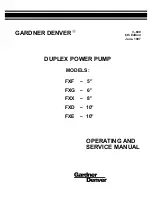
OM-00675
10 SERIES
PAGE B - 6
INSTALLATION
A manual shut‐off valve should not be
installed in any bypass line. A manual
shut‐off valve may inadvertently be left
closed during operation. A pump which
has lost prime may continue to operate
without reaching prime, causing dan
gerous overheating and possible explo
sive rupture of the pump casing. Per
sonnel could be severely injured.
Allow an over‐heated pump to cool be
fore servicing. Do not remove plates,
covers, gauges, or fittings from an over‐
heated pump. Liquid within the pump
can reach boiling temperatures, and va
por pressure within the pump can cause
parts being disengaged to be ejected
with great force. After the pump cools,
drain the liquid from the pump by re
moving the casing drain plug. Use cau
tion when removing the plug to prevent
injury to personnel from hot liquid.
AUTOMATIC AIR RELEASE VALVE
When properly installed and correctly adjusted to
the specific hydraulic operating conditions of the
application, the Gorman‐Rupp Automatic Air Re
lease Valve will permit air to escape through the by
pass line, and then close automatically when the
pump is fully primed and pumping at full capacity.
Theory of Operation
É
É
É
Figure 4. Valve in Open Position
Figures 4 and 5 show a cross‐sectional view of the
Automatic Air Release Valve, and a corresponding
description of operation.During the priming cycle,
air from the pump casing flows through the bypass
line, and passes through the Air Release Valve to
the wet well (Figure 4).
É
É
É
Figure 5. Valve in Closed Position
When the pump is fully primed, pressure resulting
from flow against the valve diaphragm com
presses the spring and closes the valve (Figure 5).
The valve will remain closed, reducing the bypass
of liquid to 1 to 5 gallons per minute, until the pump
loses its prime or stops.
Some leakage (1 to 5 gallons (3,8 to 18,9
Liters) per minute) will occur when the
valve is fully closed. Be sure the bypass
line is directed back to the wet well or
tank to prevent hazardous spills.
When the pump shuts down, the spring returns the
diaphragm to its original position. Any solids that
may have accumulated in the diaphragm chamber
settle to the bottom and are flushed out during the
next priming cycle.
NOTE
The valve will remain open if the pump does not
reach its designed capacity or head. Valve closing
pressure is dependent upon the discharge head of
the pump at full capacity. The range of the valve
closing pressure is established by the tension rate
of the spring as ordered from the factory. Valve clos
ing pressure can be further adjusted to the exact
system requirements by moving the spring retain
ing pin up or down the plunger rod to increase or
decrease tension on the spring. Contact your Gor
man‐Rupp distributor or the Gorman‐Rupp Compa
Содержание 14C2-F3L
Страница 6: ......
Страница 16: ......
Страница 26: ...10 SERIES OM 00675 MAINTENANCE REPAIR PAGE E 2 PARTSPAGE SECTION DRAWING Figure 1 Pump Model 14C2 F3L ...
Страница 28: ...10 SERIES OM 00675 MAINTENANCE REPAIR PAGE E 4 ILLUSTRATION Figure 2 46143 158 Power Unit Kit ...
Страница 30: ...10 SERIES OM 00675 MAINTENANCE REPAIR PAGE E 6 SECTION DRAWING Figure 3 14C2 SAE 4 10 Pump End Assembly ...
Страница 43: ......















































